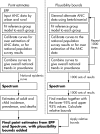Improved plausibility bounds about the 2005 HIV and AIDS estimates
- PMID: 16735297
- PMCID: PMC2576724
- DOI: 10.1136/sti.2006.021097
Improved plausibility bounds about the 2005 HIV and AIDS estimates
Abstract
Background: Since 1998 the Joint United Nations Programme on HIV/AIDS and the World Health Organization has provided estimates on the magnitude of the HIV epidemic for individual countries. Starting with the 2003 estimates, plausibility bounds about the estimates were also reported. The bounds are intended to serve as a guide as to what reasonable or plausible ranges are for the uncertainty in HIV incidence, prevalence, and mortality.
Methods: Plausibility bounds were developed for three situations: for countries with generalised epidemics, for countries with low level or concentrated epidemics (LLC), and for regions. The techniques used build on those developed for the previous reporting round. However the current bounds are based on the available surveillance and survey data from each individual country rather than on data from a few prototypical countries.
Results: The uncertainty around the HIV estimates depends on the quality of the surveillance system in the country. Countries with population based HIV seroprevalence surveys have the tightest plausibility bounds (average relative range about the adult HIV prevalence (ARR) of -18% to +19%.) Generalised epidemic countries without a survey have the next tightest ranges (average ARR of -46% to +59%). Those LLC countries which have conducted multiple surveys over time for HIV among the populations most at risk have the bounds similar to those in generalised epidemic countries (ARR -40% to +67%). As the number and quality of the studies in LLC countries goes down, the plausibility bounds increase (ARR of -38% to +102% for countries with medium quality data and ARR of -53% to +183% for countries with poor quality data). The plausibility bounds for regions directly reflect the bounds for the countries in those regions.
Conclusions: Although scientific, the plausibility bounds do not represent and should not be interpreted as formal statistical confidence intervals. However in order to make the bounds as meaningful as possible the authors have tried to apply reasonable statistical approaches and assumptions to their derivation. An understanding of the uncertainty in the HIV estimates may help policy makers take better informed decisions to address the epidemic in their respective countries.
References
-
- The United Nations Joint Programme of HIV/AIDS (UNAIDS) Report on the global AIDS epidemic. 4th global report. UNAIDS, Geneva 2004
-
- The United Nations Joint Programme of HIV/AIDS (UNAIDS) Report on the Global HIV/AIDS Epidemic, 2002. UNAIDS, Geneva 2002
MeSH terms
LinkOut - more resources
Full Text Sources
Medical
Research Materials


